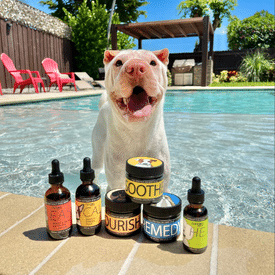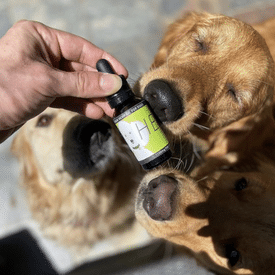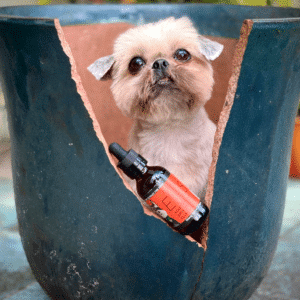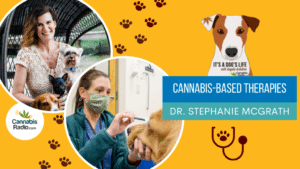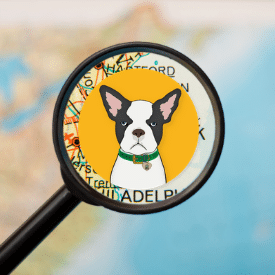How To Read A Certificate Of Analysis (COA)

One of the things people ask us about a lot is how to know for sure which CBD and cannabis products are ‘good’ for their pets and which they should avoid. There are a lot of things you can look for to find a quality product, but this is an unregulated industry and the only way to know if the bark is worth the bite, is by checking the company’s Certificate Of Analysis (COA).
Table of Contents
What is a Certificate of Analysis (COA)?
Whether they call them lab results, certificate of analysis or COA, this document shows you exactly what is in your product at the time it was bottled. This report will give you the specific quantity for each cannabinoid, like CBD and THC, that are in the product. This is how you can be sure that you are indeed buying a full-spectrum product, which research has shown is the most effective type of cannabis medicine.
COA & Third-Party Labs
A COA should always be issued by a third-party lab. That means the company has paid to have an outside company analyze the contents of their product and generate a report that tells you everything you need to know about it. You can determine if this is a third party by checking the logo and contact info on the document. If the lab shares a logo or name with the company you are buying from, they are probably affiliated.
Feel free to give them a call and ask about the reports they produce!
By having the testing done in a non-affiliated lab, we can be pretty sure the company selling the item has no bias in the reporting of its contents. This is so important. Without this document, there is no way to prove that what is printed on the bottle is indeed true of what’s inside. When we are dealing with something as serious as a health supplement, the importance of transparency cannot be overstated and most companies worth their stuff will gladly offer a COA.

But don’t let that confuse you! There are a few simple things in all these reports that you can focus on.
How To Read A Certificate Of Analysis (COA)
The main thing you’re going to want to look for is how much of each cannabinoid like CBD and THC was found during testing. There are over 114 known cannabinoids, most of which are in such small quantities that they don’t show up in typical lab tests. That doesn’t mean they aren’t present, they’re just in really small proportions.
Carrier oils like hemp seed oil or MCT are great for improving the bioavailability of a hemp extract, but this can reduce the amount of cannabinoids to less than detectable levels. That being said, a full-spectrum hemp or cannabis extract should report quantitative data for CBD, THC, and at least a couple of the minor-cannabinoids like CBG or CBC.
FIGURE 1

What You Want To See in a Certificate of Analysis (COA)
If you look at the image labeled Figure 1, you will see a few different ways this particular lab reports THC levels. They give you the percentage of total weight (which for a hemp product must be below .3% THC). They also give you the mg/g and the total mg per bottle. This lab has given you a nice colorful graph to show the relative concentration of all the detected cannabinoids. As you’d expect for a hemp extract, CBD reports the highest level. Were this a marijuana tincture, it would most likely show a higher level of THC.
Once we know that all the good stuff is accounted for, we need to make sure the results confirm that it is free of all the contaminants and other stuff we don’t want.
What You Don’t Want To See in a Certificate Of Analysis (COA)
The COA is also valuable as it can prove the product is free of pesticides, heavy metals, pathogens, and other nasty things that could harm your pet.
Two types of detection that you want to be aware of are LOD and LOQ. They are similar but are different ways of showing if something was detected or not.
- LOD, or limit of detection = the lowest level that an analyte can be detected by the tests.
- LOQ, meaning limit of quantitation = the lowest concentration at which the analyte can be quantitated reliably at defined levels. In other words, the lowest level that a compound can be accurately measured, beyond just being able to detect it.
If anything is reported less than (LOQ), or LOD, that means it is virtually non-existent in the product.
Most labs will test for a long list of the most common pesticides, which should be showing ‘not detected’ or ‘ND’. They can and should also test for heavy metals and pathogens like E. Coli or salmonella.
Why is a Certificate Of Analysis Important?
Let’s be honest, there are a lot of questionable CBD products on the market right now. Without any regulation, it’s like the wild west out here. Products are being sold as one thing, then later found to have little or no CBD content at all.
Just because they give you a COA, doesn’t mean there isn’t still some shady business going on. You may find test results for products that claim to be full-spectrum despite their lab test showing THC levels below the LOQ. This means the THC was pretty much undetectable.
It’s really unfortunate that this is something that people need to watch out for and it reinforces the reason that it’s a great idea to build a relationship with your local independent pet shop. The reputable ones have done the necessary work to vet the companies they carry and they care about what they are selling.
Where Can I Find a Certificate of Analysis?
Companies should make it easy for you to find this information. If their lab test results are not clearly listed and accessible, they are probably hiding something. I’m always happy to give props to companies that are doing things right. There are millions of pets that could benefit from cannabis and we just can’t help them all.
By providing a COA, cannabis companies like these are operating with the transparency necessary for consumers to ensure at a minimum that what they say about their product on the label is reflective of what’s inside the bottle. You can always call or email them directly and ask them to send you their COA’s. Transparency is so important and the good companies will be happy to prove themselves!

